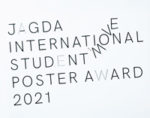入選作品集(展覧会図録)発行
「JAGDA国際学生ポスターアワード2019」入選作品集(展覧会図録)を発行しました。
入賞・入選213作品、審査員による講評、審査風景等を収録。
展覧会場(国立新美術館 展示室1C、12/9まで)、JAGDA事務局、JAGDA Online Shopにて販売しています。
発行:2019年11月27日
編集:JAGDA学生グランプリ委員会
デザイン:居山浩二
体裁:B5変形(天地260×186mm)/88ページ/カラー
審査講評のうち、ジャンピン・ヘ氏のコメントは紙面の都合上要約して掲載しています。
以下に全文を記載いたします。
—
I was looking forward to this poster competition with the theme of “Line” from the beginning. Unlike those in Europe, this competition is based on a neutral and vague concept that is more suitable for an art biennale or a contemporary art group exhibition. In Europe, especially in countries like Switzerland, Germany and France with more than 300 years of poster history, poster is a medium that clearly communicates, which, whether used for commercial or cultural purposes, is usually required to deliver clear messages. As the vehicles travel faster on the streets, posters also need to provide more streamlined and intuitive information.
For this student-oriented poster competition, I think that such a neutral concept can provide students with a good opportunity to express their free will and exercise their outstanding expression. Even I expect to see some experimental works. In fact, I saw many excellent works that surprised me in this competition. I think the results of this poster competition are remarkable.
And I am particularly impressed in the two aspects as below. On the one hand, because of the established theme of the competition, most of the students preferred to downplay text and highlight the creation of graphics to make it more interesting and visually appealing. And many even opt to design two or three pieces to form a series of works. For the judges, that must add the artistic composition of the poster works, and cut down the part of precise information thereof. Admittedly, we would all try to understand the works based on the “Line” concept, though many could be rather difficult to convince the audience if removed from the given context of the theme.
Secondly, I think the poster works have demonstrated a generally uniform tone of aesthetics. If the staff haven’t explained, I wouldn’t believe these works come from many different countries (mostly Asian countries). I’m not sure whether all the students have deliberately designed so for JAGDA, or that is just a general pursuit of design education today. Maybe it’s also an educational feature of design schools in Asia.
I hope the next JAGDA poster competition will use a theme that bears more practical significance, for example, it could choose a social issue, or a designer’s presentation of views on a current event, or just let the world know more about the power of the graphic design sector. I also expect that more countries will send students to take part in the event, so that more excellent works from varied countries and areas will be gathered, exhibiting more varied techniques of expression and different design styles. I wish JAGDA all success.
Jianping He (Berlin, Oct 7, 2019)


